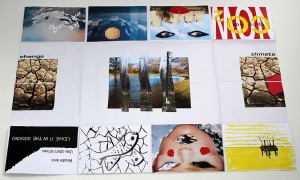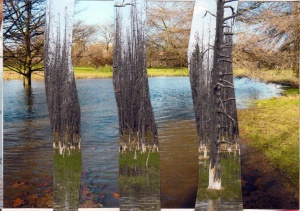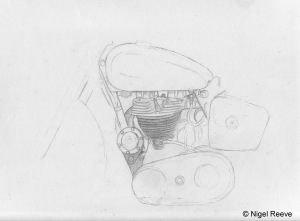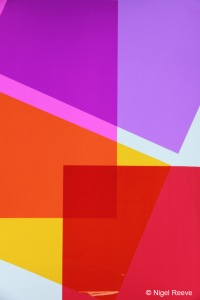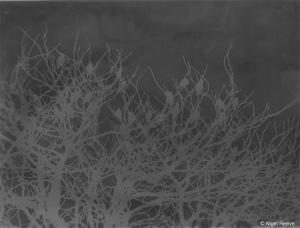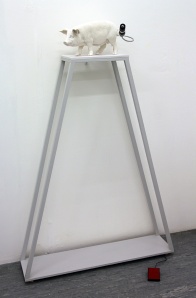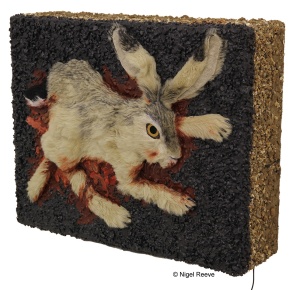It has been a varied and busy week – very difficult to summarise. Having obtained a copy of Saturday’s Guardian (28th Sept) with supplements and a fashion magazine, I set about the task of picking out a story on which to base the creation of a series of typographic exercises and collages. I chose a pair of articles in The Guardian on the same theme of climate change by Fiona Harvey “Just 30 years to calamity if we carry on blowing the carbon budget, says IPCC” (page 17) and the associated article by George Monbiot “Climate change? Try catastrophic climate breakdown” (pages 1& 17).
Creating a series of responses to these articles using hand-drawn type with the aim of communicating 8 key points of content turned out to be a really interesting process although we had to work fast. We were asked to explore a range of different type styles and exploit outlines, reversing-out and creative methods of presenting text and were shown a fascinating series of images by typographers and fine artists using type in their work. Included in the long list were Kate Moross (http://www.studiomoross.com), Amy Unikewicz (http://jellyfever.com) who among other things likes to use objects that mimic letter forms, and Donald Wall (1971) Visionary Cities: Arcology of Paolo Soleri, Praeger Publishers, NY.
During the week and this weekend I spent time on the internet and in the library looking at the use of letter forms by graphic artists (the book covers were a good start!). Among the sites I found this helpful link http://www.moonsaildesign.com/typography/inspiring-typographic-artists/ from which I picked out the work of Craig Ward http://wordsarepictures.co.uk/about/.
We were also introduced to book designs of many forms – maze books, concertina books, hidden books, cut outs and pop-ups and so on. Having raised two children I have seen many kinds of inventive books for youngsters. If you have never seen Janet & Allan Ahlberg’s The Jolly Postman or Other People’s Letters, Puffin Books (1999) then grow up and read it. But the lecture really expanded my view of books as forms of art. The practical introduction to collage turned out to be just as interesting. We were shown a number of creative techniques which helped me see the possibilities for using the images I had brought in for work on the climate change book project.
My hand-drawn typography was primitive but I liked 3 of the 8 I did and I used those in the book. The 16 collage and sketch images making up an A3 page were more successful. Most of the photographic sources were my own (Wikipedia commons supplied a Moscow traffic jam, cracked mud and a tornado). Magazine images supplied faces and spectacles and a window envelope provided a window (no kidding) a pattern and a “Hurry” message. Some old Letraset I had came in handy too.
 The book design I came up with is a fold-out – probably better shown than described.
The book design I came up with is a fold-out – probably better shown than described.
The mirror card panels (4th image) when vertical reflect the text and imagery around them as well as the reader. The final (5th) image shows the back ‘cover’ with one of the more striking collages, superimposing a shot of a forest killed by flooding that I took in Yellowstone (USA) with one of some extraordinary flooding in Hyde Park (London) in 2010.
Making the book, the techniques involved and developing the use of type and collage in the book has been good fun and I feel that it really has developed my skills. Having to work really fast has been a strain but interestingly sometimes some creative plusses come from problems. For example, being locked out of all the photocopiers by a paper misfeed (unable to log on to another while the jammed one still had me logged in and unable to log out until the job was complete) in the final stage of book construction forced me to compromise on getting some of the front and back cover images exactly the ‘right’ size – but it gave me space for the title lettering and perhaps the negative space around the image adds impact. Anyway, I got good feedback from a fellow student in a peer-review session.
In the middle of this week, Wednesday, was our contextual studies and drawing classes. In groups of about 6 the class researched different modern art movements. We looked at Surrealism – which sprang from Dadaism and was strongly linked with Freudian psychology in its views of dream worlds, imagination and the subconscious. I was able to remind myself about some of the weird and wonderful works and philosophy of its proponents – particularly André Breton, Max Ernst and Man Ray, not to mention Salvador Dalí, René Magritte and others. New to me was Dorothea Tanning who did some amazing work and produced surrealist art having met Ernst in the USA during the 1940s http://www.dorotheatanning.org/.
The drawing classes were also great and we were shown some great work by established artists and other students as inspiration. Both charcoal as a medium and drawing with a long wobbly twig dipped in ink are things I have problems with – so a session involving these was worthwhile. We brought in three objects, something spiky, something creepy and something soft. My Russian copy (in metal) of a Walter Bosse designed ceramic ashtray in the form of a hedgehog, a cast iron spider paperweight and a cloth. We were asked to adopt certain ways of working, smudging, hatching, removal with an eraser etc. Some of the other students drawings were superb, but mine were pretty run-of-the-mill. Images speak a thousand words so I shall end with the one I felt to be most successful – you can imagine the others.
Related articles
- Visual Communication (katywilkins.wordpress.com)
- Visual Communications – Work in progress Maze Book in relation to a newspaper article about Miley Cyrus and Rihanna being portrayed badly in the media (hannahchristinabrown.wordpress.com)
- Visual Communication (saoirsejessy.wordpress.com)
- Visual Communication (kathrynlouiselowe.wordpress.com)
- Visual Communication Final piece (adeebatahir.wordpress.com)






